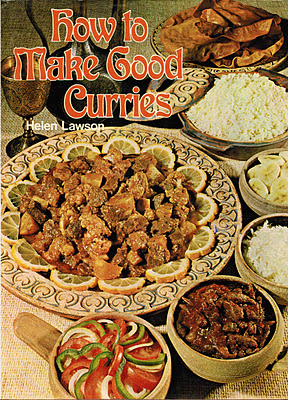I had a feeling this was going to be an interesting cookbook when I picked it up recently at a book sale. The simple title sold me, because making a good curry dish can be simple or a complicated process. Curry is one of the world’s most fascinating spices, and whether mild, hot, liquid, or dry, it is a subtle blending of spices intended to enhance, not overpower, the flavor of the main ingredients. Most of the great curries come from the countries of India, Pakistan, Ceylon, Burma, Thailand, Malaysia, and Indonesia.
Curries can vary according to the ingredients of their country of origin. Burmese curries are not highly spiced, although garlic is used generously. Ceylonese curries are very hot. Ceylon also produces some of the best cinnamon in the world, and is incorporated into their curries. As in Ceylon, coconuts are plentiful in Malaysia, and Malaysian curries are made with a stock of coconut milk. Chinese curry is usually pan-fried in a dry frying pan to bring out the true flavor of curry. Indian curry with it’s varying climatic and agricultural conditions, makes for a great variation in curries. In the north, curries are mild. The farther south you travel in India, the hotter the curries become, as in Madras, where chiles grow abundantly and are used liberally.
Since curries vary from mild to very hot, and sometimes you don’t know quite what you are buying in a can or bottle labeled simply “Curry Powder,” it might be fun to try and blend your own. The recipes in the front of this book will convince you never to buy a can again. The first recipe for “Curry Powder 1” is a fairly mild basic blend using whole seeds and pods; “Curry Powder 2” is a more robust basic blend using whole seeds and pods; “Curry Powder 3” is Madras style which means hot; and “Curry Powder 4” is a good basic blend using ready ground spices instead of whole seeds and pods. Once you try cooking with your own freshly ground spices, you will never want the packaged variety again. It will also be more economical in the long run, not to mention just a fun time in the kitchen. If you make a large quantity, give some away as gifts.
The book also explains how to make garam masala, curry paste, and curry sauces. You will learn how to enhance rice dishes, soups, breads, fish, meats, vegetables, poultry, eggs, and more. Side dishes or sambals are an essential part of a curry meal; in fact, much of the popularity of curry derives from the interesting accompaniments served with it, and you will find a whole chapter on this subject. I am a huge fan of chutneys and sauces, and there are some of the best I have ever seen. You will want to host a curry party after reading this book!









I love Indian food, but I find the idea of preparing curry from scratch very intimidating. Maybe I need to add this book to my collection.
Me, too! That’s why I loved this book. The directions are clear and the recipes sound really good. I have always wanted to make homemade curry powder and have never seen so many choices!